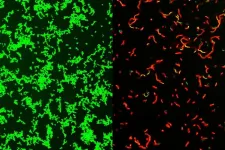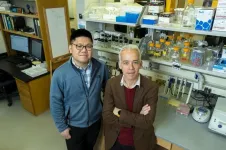(Press-News.org) Researchers at Washington University School of Medicine in St. Louis have developed a novel compound that effectively clears bacterial infections in mice, including those that can result in rare but potentially fatal “flesh-eating” illnesses. The compound could be the first of an entirely new class of antibiotics, and a gift to clinicians seeking more effective treatments against bacteria that can’t be tamed easily with current antibiotics.
The research is published Aug. 2 in Science Advances.
The compound targets gram-positive bacteria, which can cause drug-resistant staph infections, toxic shock syndrome and other illnesses that can turn deadly. It was developed through a collaboration between the labs of Scott Hultgren, PhD, the Helen L. Stoever Professor of Molecular Microbiology, and Michael Caparon, PhD, a professor of molecular microbiology, and Fredrik Almqvist, a professor of chemistry at the University of Umeå in Sweden.
A new type of antimicrobial would be good news for clinicians seeking effective treatments against pathogens that are becoming more resistant to currently available drugs, and thus much more dangerous.
“All of the gram-positive bacteria that we’ve tested have been susceptible to that compound. That includes enterococci, staphylococci, streptococci, C. difficile, which are the major pathogenic bacteria types,” said Caparon, the co-senior author. “The compounds have broad-spectrum activity against numerous bacteria.”
It’s based on a type of molecule called ring-fused 2-pyridone. Initially, Caparon and Hultgren had asked Almqvist to develop a compound that might prevent bacterial films from attaching to the surface of urethral catheters, a common cause of hospital-associated urinary tract infections. Discovering that the resulting compound had infection-fighting properties against multiple types of bacteria was a happy accident.
The team named their new family of compounds GmPcides (for gram-positive-icide). In past work, the authors showed that GmPcides can wipe out bacteria strains in petri dish experiments. In this latest study, they decided to test it on necrotizing soft-tissue infections, which are fast-spreading infections usually involving multiple types of gram-positive bacteria, for which Caparon already had a working mouse model. The best known of these, necrotizing fasciitis or “flesh-eating disease,” can quickly damage tissue severely enough to require limb amputation to control its spread. About 20% of patients with flesh-eating disease die.
This study focused on one pathogen, Streptococcus pyogenes, which is responsible for 500,000 deaths every year globally, including flesh-eating disease. Mice infected with S. pyogenes and treated with a GmPcide fared better than did untreated animals in almost every metric. They had less weight loss, the ulcers characteristic of the infection were smaller, and they fought off the infection faster.
The compound appeared to reduce the virulence of the bacteria and, remarkably, speed up post-infection healing of the damaged areas of the skin.
It is not clear how GmPcides accomplish all of this, but microscopic examination revealed that the treatment appears to have a significant effect on bacterial cell membranes, which are the outer wrapping of the microbes.
“One of the jobs of a membrane is to exclude material from the outside,” Caparon said. “We know that within five to ten minutes of treatment with GmPcide, the membranes start to become permeable and allow things that normally should be excluded to enter into the bacteria, which suggests that those membranes have been damaged.”
This can disrupt the bacteria’s own functions, including those that cause damage to their host, and make the bacteria less effective at combating the host’s immune response to infections.
In addition to their antibacterial effectiveness, GmPcides appear to be less likely to lead to drug-resistant strains. Experiments designed to create resistant bacteria found very few cells able to withstand treatment and thus pass on their advantages to the next generation of bacteria.
Caparon explained that there is a long way to go before GmPcides are likely to find their way into local pharmacies. Caparon, Hultgren and Almqvist have patented the compound used in the study and licensed it to a company, QureTech Bio, in which they have an ownership stake, with the expectation that they will be able to collaborate with a company that has the capacity to manage the pharmaceutical development and clinical trials to potentially bring GmPcides to market.
Hultgren said that the kind of collaborative science that created GmPcides is what is needed to treat intractable problems like antimicrobial resistance.
“Bacterial infections of every type are an important health problem, and they are increasingly becoming multi-drug resistant and thus harder to treat,” he said. “Interdisciplinary science facilitates the integration of different fields of study that can lead to synergistic new ideas that have the potential to help patients.”
END
New compound effective against flesh-eating bacteria
Could combat serious, antibiotic-resistant infections, mouse study indicates
2024-08-02
ELSE PRESS RELEASES FROM THIS DATE:
We should think twice before calling 911 for people experiencing a mental health crisis, advocated Harvard-trained psychiatrist Dr. Rupinder Legha
2024-08-02
We should think twice before calling 911 for people experiencing a mental health crisis, advocated Harvard-trained psychiatrist Dr. Rupinder Legha, who describes the potential risks of relying on emergency services in the US for mental health crisis management.
###
Article URL: https://journals.plos.org/mentalhealth/article?id=10.1371/journal.pmen.0000084
Article Title: Reconsidering calling 911: Is it time to set a new standard for mental health crisis response?
Author Countries: United States
Funding: The authors received no specific funding for this work. END ...
Coinfecting viruses impede each other’s ability to enter cells
2024-08-02
The process by which phages—viruses that infect and replicate within bacteria—enter cells has been studied for over 50 years. In a new study, researchers from the University of Illinois Urbana-Champaign and Texas A&M University have used cutting-edge techniques to look at this process at the level of a single cell.
“The field of phage biology has seen an explosion over the last decade because more researchers are realizing the significance of phages in ecology, evolution, and biotechnology,” said Ido Golding (CAIM/IGOH), a professor of physics. “This work is unique ...
DART forward: Five papers shed new light on asteroids from world’s first planetary defense test
2024-08-02
In the months that followed NASA’s Double Asteroid Redirection Test (DART) mission, which sent a spacecraft to intentionally collide with an asteroid moonlet, the science team verified that kinetic impact was a viable deflection technique, proving one effective method of preventing future asteroid strikes on Earth.
Since then, researchers have continued studying data collected from the successful experiment, focusing specifically on surface features of the binary asteroid system, composed of moonlet Dimorphos and parent asteroid Didymos.
In recently published papers in Nature Communications, the team explored the geology of the asteroid system encountered in 2022 to characterize its ...
Feeling judged by your doctor? You might be right
2024-08-02
When an individual visits their doctor, they aren’t supposed to keep secrets. Unless patients are forthcoming about their symptoms, behaviors, and health-related beliefs, it’s hard for healthcare professionals to effectively diagnose and treat illnesses—or to advise and educate patients about how to take better care of themselves in the future.
There’s only one problem: new research from Stevens Institute of Technology shows that many people believe they may be judged if they share mistaken beliefs with their care team—and that doctors really do take strongly negative views of patients who disclose incorrect ...
nTIDE July 2024 Jobs Report: People with disabilities hold steady in labor market despite federal reserve's attempts to slow economy
2024-08-02
East Hanover, NJ – August 2, 2024 – Following significant gains since the post-pandemic lockdown, employment rates for people with disabilities have plateaued, remaining near historic high levels over the past year despite the Federal Reserve’s efforts to slow the economy, according to today’s National Trends in Disability Employment – semi-monthly update (nTIDE) issued by Kessler Foundation and the University of New Hampshire’s Institute on Disability (UNH-IOD).
Year-to-Year nTIDE Numbers (comparing July 2023 to July 2024)
Based on data from the U.S. Bureau of Labor Statistics ...
Dopamine physiology in the brain unveiled through cutting-edge brain engineering!
2024-08-02
□ DGIST (President Lee Kunwoo) Department of Brain Sciences Professor Lee Kwang and his team have discovered a new correlation between neural signaling in the brain and dopamine signaling in the striatum. The human brain requires fast neural signal processing in a short period of less than a second. Dopamine is known to have the strongest effect on brain neural signals, but the research team’s newly developed “optical neural chip-based multiple brain signal monitoring technology” shows that changes in dopamine signals within the physiological range do not affect brain neural signal ...
Precise package delivery in cells? Successful observation of endosome behavior provides new clues for disease treatment
2024-08-02
□ A team led by Professor Seo Dae-ha of the Department of Physics and Chemistry at DGIST (President Lee Kun-woo) has developed new real-time microscopy technology and successfully observed the behavior of “motor proteins”[1], which may hold the key to unraveling the efficient material transport strategy of cells. The research team used nanoparticle probe, high-resolution microscopy, and Fourier transform algorithm technologies to develop “Fourier transform-based plasmonic dark-field microscopy” (FT-pdf microscopy) with positional and angular accuracy comparable to electron microscopy, achieving the highest level of existing ...
Sustainable green energy innovation! Development of new technology for energy device that heals itself from damage incurred while generating electricity
2024-08-02
□ A team led by Professor Lee Joo-hyuk of the Department of Energy Engineering at DGIST (President Lee Kunwoo) has developed an ionic polyurethane-based triboelectric generator[1]with self-healing, biodegradable[2], and high electro-positive properties. The device has been designed as a green energy device that can minimize the impact on the environment by facilitating self-healing and biodegradability, while significantly enhancing power output performance through the use of ionic liquid. Based on these properties, it is expected to be used as a sustainable power source in next-generation soft electronic devices and wearable devices.
- ...
White Matter May Aid Recovery From Spinal Cord Injuries: Study
2024-08-02
Injuries, infection and inflammatory diseases that damage the spinal cord can lead to intractable pain and disability. Some degree of recovery may be possible. The question is, how best to stimulate the regrowth and healing of damaged nerves.
At the Vanderbilt University Institute of Imaging Science (VUIIS), scientists are focusing on a previously understudied part of the brain and spinal cord — white matter. Their discoveries could lead to treatments that restore nerve activity through the targeted delivery of electromagnetic stimuli or drugs.
As in the brain, the spinal cord is made up nerve cell bodies (gray matter), which process sensation and control voluntary movement, and ...
Reduction in folate intake linked to healthier aging in animal models
2024-08-02
August 1, 2024 - by Ashley Vargo - In a study published in Life Science Alliance, Texas A&M AgriLife Research scientists found that decreasing folate intake can support healthier metabolisms in aging animal models, challenging the conventional belief that high folate consumption universally benefits health.
The study was led by Michael Polymenis, Ph.D., professor and associate head of graduate programs in the Texas A&M College of Agriculture and Life Sciences Department of Biochemistry and Biophysics.
Michael Polymenis, Ph.D., principal investigator, ...
LAST 30 PRESS RELEASES:
Coffee as a staining agent substitute in electron microscopy
Revealing the diversity of olfactory receptors in hagfish and its implications for early vertebrate evolution
Development of an ultrasonic sensor capable of cuffless, non-invasive blood pressure measurement
Longer treatment with medications for opioid use disorder is associated with greater probability of survival
Strategy over morality can help conservation campaigns reduce ivory demand, research shows
Rising temperatures reshape microbial carbon cycling during animal carcass decomposition in water
Achieving ultra-low-power explosive jumps via locust bio-hybrid muscle actuators
Plant-derived phenolic acids revive the power of tetracycline against drug-resistant bacteria
Cooperation: A costly affair in bacterial social behaviour?
Viruses in wastewater: Silent drivers of pollution removal and antibiotic resistance
Sub-iethal water disinfection may accelerate the spread of antibiotic resistance
Three in four new Australian moms struggle with body image
Post-stroke injection protects the brain in preclinical study
Cardiovascular risk score predicts multiple eye diseases
Health: estimated one in ten British adults used or interested in GLP-1 medications for weight loss
Exercise to treat depression yields similar results to therapy
Whooping cough vaccination for pregnant women strengthens babies’ immune system
Dramatic decline in new cases of orphanhood in Uganda driven by HIV treatment and prevention programs
Stopping weight loss drugs linked to weight regain and reversal of heart health markers
Higher intake of food preservatives linked to increased cancer risk
Mass General Brigham–developed cholera vaccine completes phase 1 trial
First experimental validation of a “150-year-old chemical common sense” direct visualization of the molecular structural changes in the ultrafast anthracene [4+4] photocycloaddition reaction
Lack of support for people on weight loss drugs leaves them vulnerable to nutritional deficiencies, say experts
Dogs’ dinners can have greater climate impact than owners’
Are you ready to swap salmon for sprats and sardines?
1.6 million UK adults used weight loss drugs in past year
American College of Cardiology comments on new dietary guidelines for Americans
American Society of Gene & Cell Therapy and Orphan Therapeutics Accelerator partner to advance and commercialize promising rare disease treatments
One in 14 patients having day case surgery have new or worse chronic pain 3 months after their operation
New study highlights link between eviction rates and gun violence
[Press-News.org] New compound effective against flesh-eating bacteriaCould combat serious, antibiotic-resistant infections, mouse study indicates






